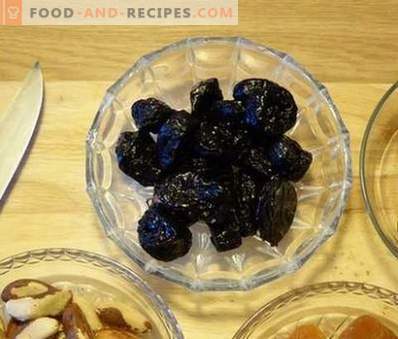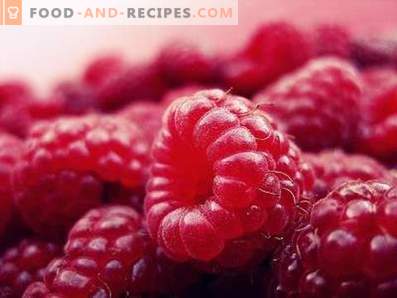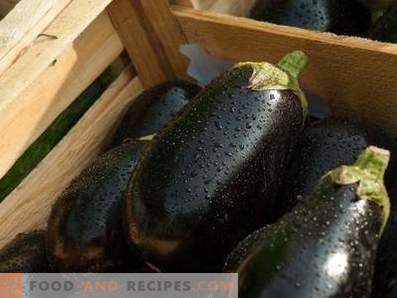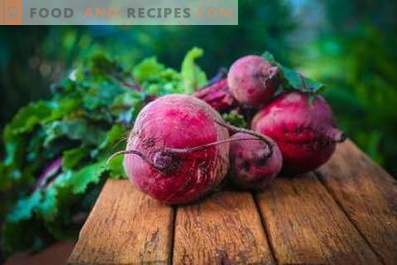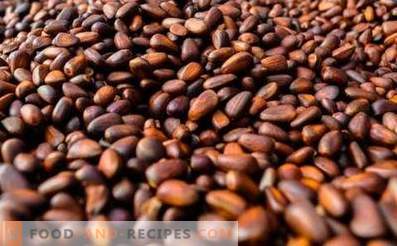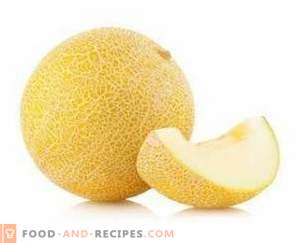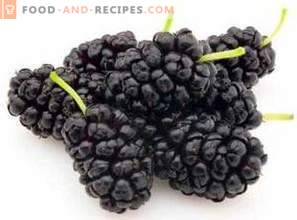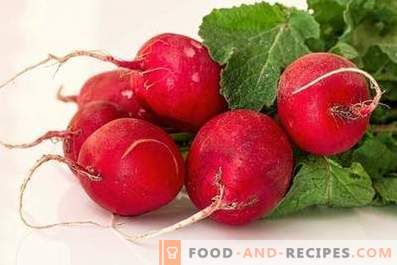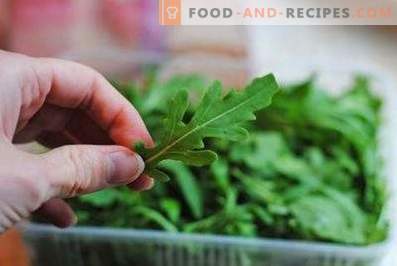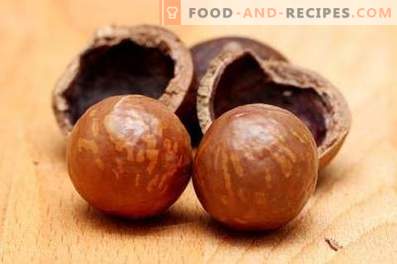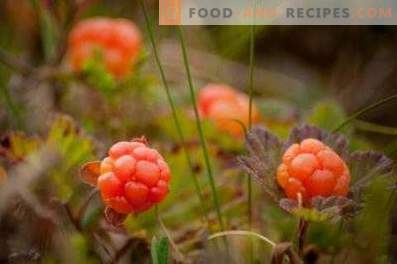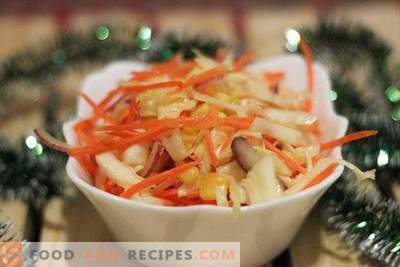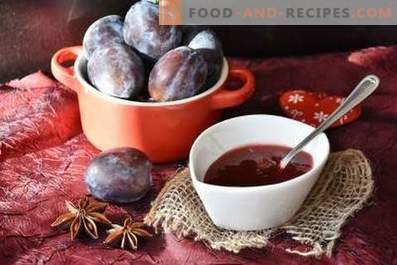
Plum is a widespread fruit plant belonging to the Rosaceae family. The native land of this species is the vast territory stretching from the eastern coast of the Adriatic Sea to the Eastern Caucasus. Scientists suggest that wild species of this culture appeared as a result of the crossing of two plants - cherry plum and thorns.
Plum is a tree with an egg-shaped crown, reaching 14-15 meters in height. The plant has a taproot, with most of its roots located at a depth of up to 40 cm. The trunk of the tree is covered with gray or brown-brown bark. Smooth top and bottom pubescent leaves have a green color and an elliptical shape. Leaf blades can have serrate or crenate edge, up to 50 mm wide and 100 mm long. May plum blossoms in small white flowers. The fruit of the culture is a single-sided lilac, yellow, purple, blue-black, red or pale green color with juicy sweet or sour-sweet pulp.
Choose delicious and juicy plums is easy. When purchasing the fruits of this plant in stores and markets, you must:
- refuse to buy too soft plums or fruits with too thin skin (such fruits deteriorate very quickly and cannot be stored);
- give preference to elastic fruits with a rather thick peel covered with bloom;
- Refuse to purchase damaged or immature fruits.
Fresh plums are stored in a refrigerator in plastic bags with holes. Properly selected fruits do not lose their taste and healing properties for 2, 5-3 weeks. Dried plums (prunes) are stored in glass containers or linen bags in cool, protected from moisture and insects. Plums are eaten both raw and processed. The fruits of this plant are frozen, dried, pickled, dried and moistened, used to make juices, compotes, jams, candied fruits, jellies and other confectionery products. In addition, liqueurs, liqueurs, liqueurs and special vodka - plum brandy are made from plums. Fruits and other parts of this plant are used in cosmetology and traditional medicine.
Nutritional value of plums and vitamins in their composition
Plum is a sweet fruit, rich in carbohydrates (sugars), fiber, vitamins and other beneficial compounds.
Nutritional value 100 g plum:
- 0, 794 g of proteins;
- 0, 292 g of fat;
- 9, 574 g of carbohydrates;
- 1, 484 g of fiber;
- 0, 999 g of organic acids;
- 0, 467 g of ash;
- 0, 094 g of starch;
- 9, 411 g of disaccharides, monosaccharides;
- 88, 112 g of water.
Vitamins in the composition of plums (per 100 g):
- 0, 557 mg of vitamin PP;
- 0.059 mg of thiamine (B1);
- 16, 554 μg of retinol equivalent (A);
- 0, 092 mg of beta-carotene;
- 9, 994 mg of ascorbic acid (C);
- 0, 039 mg of riboflavin (B2);
- 0, 199 mg of pantothenic acid (B5);
- 076 mg of pyridoxine acid (B6);
- 0, 579 mg of vitamin E;
- 0.664 mg of niacin equivalent;
- 1, 497 μg of folic acid (B9).
Calories of plums
- Caloric value of plums (100 g) - 48, 779 kcal.
- The caloric value of one plum (average weight - 25 g) - 12, 195 kcal.
- The caloric content of dried plums (prunes) is 230, 112 kcal.
- Calorie plum puree - 39, 919 kcal.
- Caloric value of plum - 301, 781 kcal.
- Calorie plum jam - 287, 414 kcal.
Trace elements and macronutrients in the composition of plums
Macroelements in the pulp of plums (per 100 g):
- 19, 799 mg of calcium;
- 213, 949 mg of potassium;
- 0, 919 mg of chlorine;
- 8, 779 mg of magnesium;
- 19, 447 mg of phosphorus;
- 5, 997 mg of sulfur;
- 17, 669 mg of sodium.
Trace elements in the composition of plums (100 g):
- 0, 484 mg of iron;
- 0, 109 mg of manganese;
- 2, 112 μg of fluorine;
- 14, 444 μg of nickel;
- 0.097 mg of zinc;
- 3, 664 mcg of iodine;
- 3, 971 mg of silicon;
- 3, 991 mcg of chromium;
- 7,916 μg of molybdenum;
- 0, 989 mkg cobalt;
- 86, 292 mcg copper.
Useful properties of plums
- Freshly picked fruits of plums, prunes, plum compotes and juices have mild laxative properties. Nutritionists recommend including them in the daily menu of persons suffering from chronic constipation and intestinal atony.
- Plums are a rich natural source of potassium and coumarins, which have a beneficial effect on the cardiovascular system. Regular consumption of well-ripened fruits of this plant strengthens the myocardium and expands the coronary arteries, helps prevent the development of thrombosis.
- Plum pulp stimulates the synthesis of gastric juice and increases appetite.
- Both freshly harvested and dried plums contain substances that promote the elimination of “bad” cholesterol from the body. Regular consumption of the fruits of this culture can reduce the risk of formation of cholesterol plaques on the vascular walls and the development of atherosclerosis.
- Pectins present in plum pulp inhibit the development of putrefactive processes in the intestine.
- Plum is a rich natural source of ascorbic acid. Regular consumption of the fruits of this plant and dishes prepared on their basis in the cold season can reduce the risk of SARS.
- As part of the plum juice, there are compounds with antiseptic properties and destroying the pathogenic microflora in the oral cavity and in the digestive tract.
- Compounds present in the composition of plums have diuretic properties and contribute to the removal of excess fluids and salts from the body.
- The composition of the plum juice contains compounds that help lower blood pressure. Nutritionists recommend including this drink in the daily menu of persons suffering from hypertension.
- In the plum pulp there are substances that contribute to the development of blood cells. Thus, plum has a positive effect on the work of the blood system.
- Plum pulp strengthens the liver, helping to remove harmful compounds from the body.
- Plums are a rich natural source of iron. Regular consumption of the fruits of this culture helps people suffering from iron deficiency anemia, to fill the deficiency of this substance in the body.
- Vitamins, antioxidants and other compounds contained in plums, prevent premature cell aging, improve the condition of the skin, nail plates and hair.
- Prunes help reduce body temperature during fever.
- Substances present in the plum pulp, regulate metabolic processes in the body, accelerate metabolism.
- Plums are a natural source of B vitamins. Regular consumption of the fruits of this crop for food has a beneficial effect on the nervous system, helps reduce the negative impact of stressful situations on the body and quickly overcome depression.
- Plum pulp is actively used in cosmetology for the preparation of anti-aging masks, giving skin elasticity and elasticity. For normal or too dry skin, a cosmetic product made from plum pulp and sour cream is suitable (sometimes sour cream is replaced with high-fat cream). For the treatment of oily skin often use masks of whipped protein and plum puree. A full course of skin treatment includes 17-20 masks.
Useful properties of plum leaves, bark, flowers and wood
- A decoction made from plum leaves has regenerative properties. The specified tool is used for the preparation of wound healing lotions and compresses. In addition, gruel from crushed fresh plum leaves (or steamed dry laminae of this plant) is applied to purulent wounds or ulcers, thereby stimulating regeneration processes.
- A weak decoction of plum leaves is used for rinsing the mouth during stomatitis and periodontal disease.
- Decoction of plum leaves - an effective means of combating inflammatory diseases of the organs of the urinary system. The remedy is taken orally in 1, 5 cups per day (daily dose is divided into three doses).
- A rich infusion of plum leaves is used to combat acute tonsillitis. The tool is used for gargling at least 2 times a day.
- In traditional medicine, a decoction based on plum leaves is used to combat acne and acne. Drug wipe problem areas of the skin.
- Plum bark decoction is an effective remedy for diarrhea. In addition, this drug is used in the treatment of erysipelas (prepared on the basis of medical lotions).
- Plum wood has diaphoretic properties. Broths based on it are used to treat colds.
- Plum bark is an effective antipyretic agent. Decoctions and infusions prepared on its basis are used to lower body temperature in febrile conditions.
- Plum blossoms have a pronounced laxative effect. Folk healers recommend that people suffering from chronic constipation, daily drink 2, 5-3 glasses of infusion, prepared on their basis.
Contraindications and harmful properties of plums
- The absolute contraindication to the consumption of plums is individual intolerance. In addition, nutritionists recommend that persons suffering from an increased tendency to develop allergic reactions, with caution include the fruits of this plant in your diet.
- Abuse of plums can cause stomach pain, diarrhea, and other disorders in the digestive system in children.
- Plum juice is contraindicated for people suffering from rheumatism and gout.
- Mothers who are breastfeeding should stop consuming prunes. Substances present in its composition can cause colic and diarrhea in infants.
- A lot of sugars are present in the pulp of plums, therefore it is recommended to include with caution in the menu of persons suffering from obesity or diabetes. In addition, diabetics and people who are overweight should completely abandon the consumption of prunes.
- Contraindications to the consumption of plums (especially those that have not fully matured) are chronic gastrointestinal diseases during periods of exacerbation and pathology, developing against the background of an increased level of acidity of the gastric juice.
